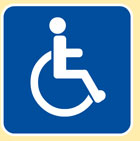 |
Some reading/research sources for this lesson included:
WORLD REPORT ON DISABILITY: http://www.unicef.org/protection/World_report_on_disability_eng.pdf
The Social Model of Disability, By Grant Carson: http://www.ukdpc.net/site/images/library/Social%20Model%20of%20Disability2.pdf
A HANDBOOK ON MAINSTREAMING DISABILITY: http://www.asksource.info/pdf/33903_vsomainstreamingdisability_2006.pdf
DISABILITY ETIQUETTE: https://www.unitedspinal.org/pdf/DisabilityEtiquette.pdf
About Disability: https://www.health.wa.gov.au/publications/daip/training_package/fscommand/Disability.pdf
Types of Disabilities: http://www.parks.ca.gov/pages/735/files/avw-02-types%20of%20disabilities.pdf
TYPES OF DISABILITY: http://www.includelebanon.org/pdf/types.pdf
A Brief Introduction to Disabilities: http://trace.wisc.edu/docs/population/briefintro.pdf
Disability Statistics 2014 Annual Report: http://www.disabilitycompendium.org/docs/default-source/2014-compendium/annual-report.pdf
Communicating Effectively With People Who Have A Disability: https://www.labor.state.ny.us/workforcenypartners/forms/communication.pdf
Principles of universal design applied to early learning environments: http://olms.cte.jhu.edu/3868
Disabled People and Development: http://hpod.pmhclients.com/pdf/Disabled-people-and-development.pdf
Tips for Teachers: Teaching Students with Disabilities: http://www.schoolmentalhealth.org/Resources/Educ/Tips%20for%20Teachers.pdf
Copyright © 2006-2019 eSchooltoday in association with BusinessGhana.com.
All Rights Reserved.
 Courtesy and respect
Courtesy and respect